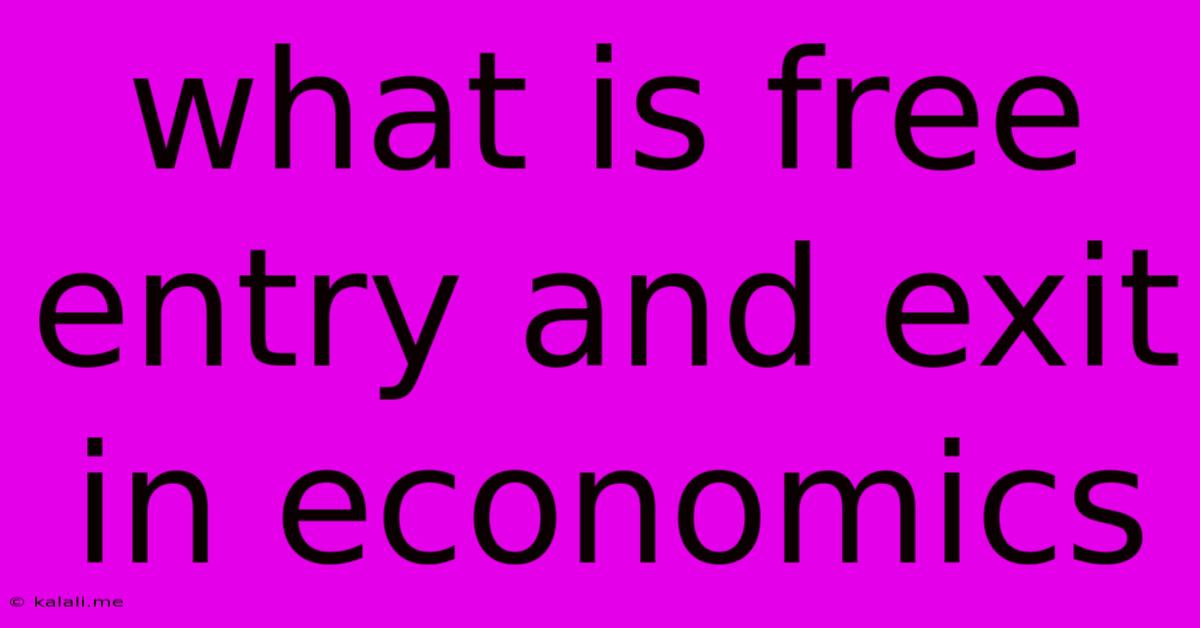What Is Free Entry And Exit In Economics
Kalali
Jun 16, 2025 · 3 min read

Table of Contents
What is Free Entry and Exit in Economics? A Comprehensive Guide
Meta Description: Understanding free entry and exit in economics is crucial for grasping market dynamics. This article explains the concept, its implications for competition, and real-world examples.
Free entry and exit are fundamental concepts in economics, particularly within the framework of perfect competition. They describe the ability of firms to easily enter or leave a market without facing significant barriers. This fluidity significantly impacts market efficiency, pricing, and the overall competitive landscape. Let's delve deeper into this important economic principle.
What Does "Free Entry" Mean?
Free entry refers to the situation where new firms can easily enter a market and begin competing with existing businesses. This ease of entry doesn't imply it's cost-free; rather, it means there are no significant obstacles preventing new entrants. These obstacles, or barriers to entry, can include:
- High start-up costs: Requiring substantial capital investment to begin operations can deter new firms.
- Legal restrictions: Patents, licenses, or government regulations can limit entry.
- Control of essential resources: If a single firm controls access to a key resource needed for production, it creates a barrier.
- Economies of scale: Existing large firms might benefit from economies of scale, making it difficult for smaller newcomers to compete on price.
- Brand loyalty: Strong brand recognition can make it hard for new entrants to gain market share.
When entry is free, the potential for profits attracts new firms. This increased competition puts downward pressure on prices and profits, ultimately benefiting consumers.
What Does "Free Exit" Mean?
Free exit is the ability of firms to easily leave a market when they are no longer profitable. This contrasts with situations where firms face significant costs or legal obstacles to shutting down operations. Such obstacles might include:
- High sunk costs: Irrecoverable investments (like specialized machinery) make exiting costly.
- Contractual obligations: Long-term contracts with suppliers or employees can create exit barriers.
- Government regulations: Regulations may make it difficult or expensive to cease operations.
- Asset specificity: If a firm's assets are specialized and have limited alternative uses, it becomes harder to exit without significant losses.
Free exit is equally important as free entry. It allows resources to be reallocated to more productive uses. When a firm is consistently unprofitable, its exit frees up resources (labor, capital, etc.) that can then be employed in other, more successful ventures.
The Combined Effect: Dynamic Competition and Efficiency
The combined effect of free entry and free exit is highly significant. It fosters a dynamic competitive environment where:
- Profits are competed away: High profits attract new entrants, increasing competition and driving down prices until profits reach a normal level (covering the opportunity cost of capital).
- Losses lead to exit: Unprofitable firms exit the market, releasing resources for more efficient uses.
- Efficient resource allocation: Resources are constantly reallocated from less productive to more productive uses.
- Consumer surplus is maximized: Consumers benefit from lower prices and increased product variety.
Examples of Markets with (and without) Free Entry and Exit
Markets Approaching Free Entry and Exit: Online retail, app development, and some service sectors (e.g., freelance writing) often exhibit relatively free entry and exit. The barriers are lower compared to industries requiring substantial capital investment.
Markets with Significant Barriers: Industries with strong economies of scale (auto manufacturing), requiring substantial regulatory approval (pharmaceuticals), or relying on exclusive access to resources (certain mining operations) often have restricted entry and exit.
Conclusion: The Importance of Free Entry and Exit
Free entry and exit are cornerstones of competitive markets and efficient resource allocation. While few real-world markets perfectly embody these conditions, understanding the concept allows economists and business strategists to better analyze market dynamics and predict the impact of policy changes on competition and consumer welfare. The degree to which a market approaches free entry and exit significantly influences its efficiency and responsiveness to changing consumer demand.
Latest Posts
Latest Posts
-
How To Create Clickable Image In Html
Jun 16, 2025
-
What Are The Factors Of 121
Jun 16, 2025
-
What Is A Theme Of The Passage
Jun 16, 2025
-
A Company That Provides Access To The Internet
Jun 16, 2025
-
Which Word Is Closest In Meaning To The Underlined Word
Jun 16, 2025
Related Post
Thank you for visiting our website which covers about What Is Free Entry And Exit In Economics . We hope the information provided has been useful to you. Feel free to contact us if you have any questions or need further assistance. See you next time and don't miss to bookmark.